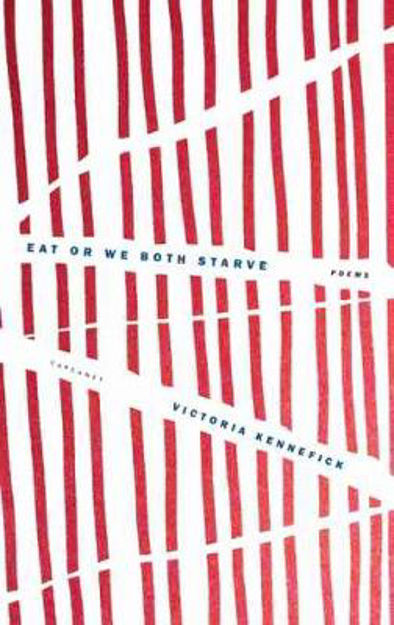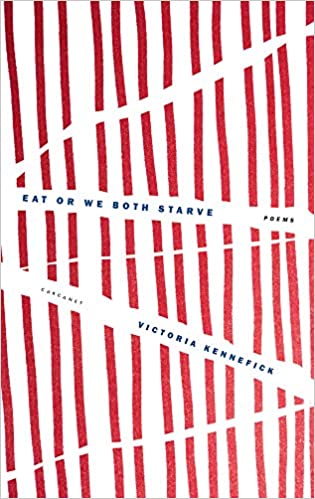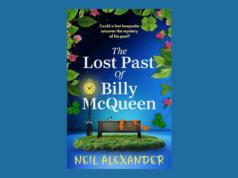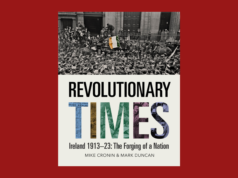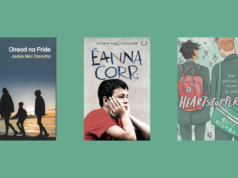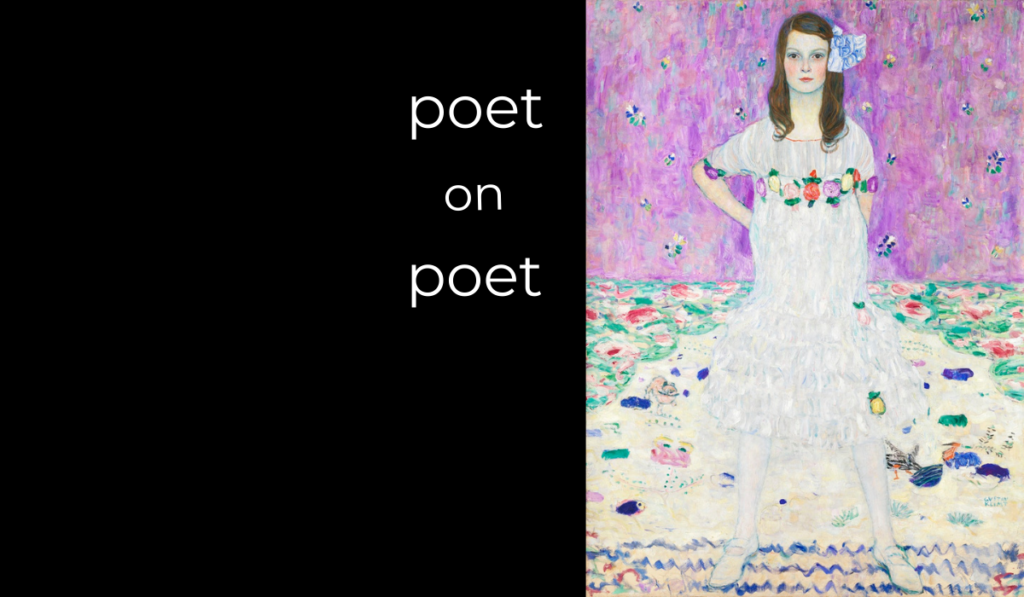
Eat or We Both Starve|Victoria Kennefick|Carcanet|ISBN 9781800170711
Sex, consumption, grief, and insecure attachments—Liz Quirke engages with Eat or We Both Starve, and interviews poet Victoria Kennefick about her collection, short-listed for the T.S Eliot Prize
by Liz Quirke
“Where did I start?” asks the opening poem of Victoria Kennefick’s debut collection Eat Or We Both Starve, published by Carcanet, home to writers such as Martina Evans, Thomas McCarthy, Sinead Morrissey, Moya Cannon and Eavan Boland.
Stablemate Rebecca Goss describes Kennefick’s work as fresh, unafraid, and visceral. A cursory look at the table of contents and the epigraph from Ovid’s Metamorphoses—“You cannot appease the hungry cravings of your wicked, gluttonous stomachs except by destroying some other life”—gives both a road map in terms of themes and energies, and sets a challenge for the reader to stay with Kennefick as she travels the rough terrain of religion, the body, and family in a way that is raw and animated.
Female heritage
As we arrive into the collection, Kennefick presents an opening poem “LEARNING TO EAT MY MOTHER, WHERE MY MOTHER IS THE TEACHER” resonating with the twin themes of familial love and consumption. “I do not want to eat her ribs, but I do. / Then strip her fingers of meat. / I hold them tenderly / in my mouth […]” (7).
Alive in Kennefick’s poems is a female heritage, be that familial poems that mention a mother figure, Kennefick herself as mother, lesser known saints, famous female figures of literary and popular culture.
I challenge any reader to find a collection where pious, Christian mystics such as medieval saint Angela of Foligno appear in quiet company with Mary Tyler Moore and Audrey Hepburn. Though beautiful in appearance, Kennefick delves into the internal lives of her saints, sinners and teachers. HUNGER STRIKES ANGELA OF FOLIGNO (1248-1309) arrives into scene of service of the bodies of the ill and the damned. “I drink pus from wounds of the unclean. / Christ, it is like water to me, sweet / as the Eucharist” (25). There is a clear poetics of consumption at work here, poems where characters are allowed to sate themselves in all their human inhumanity.
Denial
Denial looms large in this collection, as an act of piety, self-control or a way to live in a world that attempts to run away from the women that live in this collection. We understand in the poem IN MEMORY OF MARY TYLER MOORE, that part of Kennefick’s project is to adjust the lens through which the women of her collection are received, to highlight the superficiality that haunts women. Kennefick writes “She looked so good they were afraid.” (47) This line where physical appearance holds the power to intimidate, only to face a suppression and a limitation by controlling faceless producers.
Kennefick is unforgiving when assessing the male gaze or anything that limits her women, any fear that is stoked around the female body and the corporeality of femaleness.
Of the consternation over Tyler Moore’s backside, Kennefick affirms that “[t]here were no riots”, but later that Tyler Moore “got absolution from men everywhere.” The tightwire that Kennefick travels in her poems relies on consistent tension within her lines.
Control
It is to Kennefick’s credit that none of these strong inhabitants burst the banks of the poems that contain them. At Sylvia Plath’s grave IN HEPTONSTALL, Kennefick arrives to the burial site as a honeymoon stop-off, “talk[s] aloud, resist[s] the weird urge to lie on top of you/ as if we’d share something else but soil.” (65)
It is a testament to the poet’s powers and symbolic of the philosophy of this collection as a whole that the interaction with Plath’s grave is controlled and kept to the realm of the real, away from the hyperbole that mars such interactions elsewhere. This is a mature collection by a poet who has lived. Through her measured poetics, she pushes deep into the underground of female consciousness, the embodied experience of living in this world as a girl, a woman, a wife, a daughter, a poet.
Rather than use the poems as safe spaces for her personae, Kennefick sometimes allows the threat to nearly overpower the reader. In the poem (M)EAT, consumption specifically of flesh is continued from the poem above where ribs are striped and held tenderly.
The juxtaposition of the paternal pride at the consumption of marrow from bones at dinner stands starkly against later poems where we encounter a father unable to feed himself due to debilitating illness.
Body in breakdown
The poem DIET brings us back to territory that Kennefick mined in her acclaimed chapbook White Whale published by the Munster Literature Centre in 2015. That chapbook was as talented as it was heartbreaking.
In it Kennefick pays tribute to her late father and doesn’t shy away from the gritty reality of a body in breakdown. In DIET she writes of family as community, the ways that we strive to save each other when faced with the ultimate loss, and how we can forget ourselves while caring for a loved one and sometimes punish ourselves for surviving.
In The Irish Times, Kennefick wrote of her father: “Sometime into his sickness, my father began to speak in an almost stream-of-consciousness manner, using word association, metaphor and imagery, often relating to the sea, to express himself. I found that I understood him; I could translate, and felt useful again, even closer to him”. In Eat Or We Both Starve, she admits to a weakness of the body, the reduction of her own corpus to bone. In DIET, she wears the reality of losing her father on her skin and it’s a powerful, sobering a moment in a collection that demands attention at a cellular level. “But everything died / when I brought it inside that room. Still / I marvel how death turned me to bone.” (49).
Liz Quirke in conversation with Victoria Kennefick
You list yourself on Twitter as a Fulbrighter and you have a long association with Listowel Writers’ Week, what do those communities and that kinship identification do for you as a writer? Is it important for you to see writing and scholarship as part of something bigger?
Since the age of thirteen I have been an avid admirer of Sylvia Plath, and having read her poetry, diaries and anything else I could get my hands on, I noticed the term ‘Fulbright’ popped up repeatedly. Plath went to England on a Fulbright where she met Ted Hughes at Cambridge and her poetry blossomed. That was my very simplistic reading of it at the time, to my shame, but the word Fulbright, and what it represented, stuck.
It suggested so many possibilities and seemed to be something she was proud of, and something that facilitated her development as an academic, but more crucially for me, as an artist. When studying for my PhD in English, my research focused on the short stories of Flannery O’Connor and Frank O’Connor. Flannery O’Connor’s papers are held in Emory University, Atlanta, and in Georgia College and State University, Milledgeville where she grew up. Of course, accessing these archives would assist in the completion of my thesis so travelling there was on the cards, but I remember thinking, ‘Sylvia. Fulbright.’ So, I applied and was lucky enough to be awarded a scholarship.
At the orientation I met another Irish woman who had won a scholarship in psychology as was heading to San Francisco. Afterwards, when we celebrated our good fortune, I admitted my reason for applying was Plath, and she whispered back, ‘Me too.’ Isn’t that extraordinary? Two Irish students applying for the same scholarship because of one former Fulbrighter in the 1950s. I haven’t yet analysed why we both felt this was a secret. That’s how I treated my artistic life as a baby academic, as a secret! So, in my subconscious mind, my trip to America wasn’t just facilitating the completion of my PhD, it was also feeding my writing life. It gave me my bearings as a poet before I started sending out work and the time in America allowed me to write and experiment without consequence. It was life changing.
Listowel Writers’ Week made Kerry feel like home, especially when it was still new and strange. They are a brilliant, hilarious, innovative, creative and welcoming committee, and I have never once felt like a blow-in in their company. It’s a wonderful community to be part of and very dynamic. Festival time is magic – seeing all the hard work come to fruition, the weird ideas in September becoming magic events in May and having the opportunity to chat to writers from all over the world. I also met my very good friend at LWW, the writer Noel O’Regan, as we both attended our first meeting on the same night. He is one of the people who has really supported me in my writing life in Kerry. Without this grounding in such a vibrant, friendly and supportive community, I think I would have floated off, unfocused and without structure. They anchor me. I am very fortunate to be part of these organisations. I hold them close.
You pay attention in your collection to some lesser-known religious figures. Was part of your project about reanimating these figures for a contemporary audience and why? Why those figures? Why that significance?
I was particularly interested in young female saints, especially when I was choosing a confirmation name at the age of twelve or so. I read widely about them in preparation. I was heavily influenced by my late aunt, Sr. Madeleine, a Mercy sister, to select the name Thérèse in honour of St. Thérèse of Lisieux, the Little Flower. She died at the age of 25 from TB while hallucinating about banquets. Perfect. I became Victoria Margaret Mary Thérèse Kennefick. A mouthful. Victoria, after a fourth century Roman martyr and not the Queen but with three ‘Catholic’ names to balance it out it just in case.
These young women were praised for what we would now consider to be bizarre and dangerous acts like self-starvation and self-harm. I think it’s impossible to grow up Catholic and not internalise that expectation of extreme denial and purity, the two are intimately connected in the institutional elements of the faith. Not only that, but that the Virgin Mary was adored and worshipped as the ultimate example of perfect femininity. I mean, we didn’t have a chance as our bodies were inferior somehow, unclean and biological.
In the poems, I wanted to give these young, sainted women a voice, but not to impose if I could, my interpretation of their lives. They believed so fervently in what they were doing, it was also an escape in many respects from the life of marriage, sex and pregnancy. It is harrowing to consider that this was the only other option available to them at the time, so these actions as unhealthy, dangerous and toxic as they were, could be viewed as a radical act of defiance against the suffocating patriarchal society that wished to control them. What was the alternative if they couldn’t or wouldn’t conform to the restrictive and repressive role that woman had to bear historically?
While researching these saints and writing the poems in this collection, seeing them anew as an adult, I recognised in them a desire to subvert and escape the suffocating patriarchal world which bound them even more keenly. In my reading I encountered the term anorexia mirabilis, sometimes referred to as holy anorexia, which largely affected religious women during the Middle Ages in Europe. In Holy Feast and Holy Fast, Caroline Walker Bynum argues anorexia mirabilis is a legitimate form of self-expression with intentions set in antithesis to the modern disease hypothesis.
She maintains that Julian of Norwich, for example, used fasting as a valid method for communing with Christ. However, in Fasting Girls: The History of Anorexia Nervosa, Joan Jacobs Brumberg suggests that anorexia mirabilis does not occur in that period. Not because the motivations of those who self-starve shifted, but rather because the concepts for cyphering these behaviours have changed. Rudolph Bell’s Holy Anorexia and Susie Orbach’s Hunger Strike: the anorectic’s struggle as metaphor for our age, grapple with the purpose of self-starvation in a religious context too and its application in a contemporary, secular society. Hilary Mantel has also written brilliantly on the topic for The Guardian:
Within the church, pain can become productive, suffering can be put to work. But outside the church, suffering loses its meaning, degenerates into physical squalor. It has only the meaning we ascribe to it; but now we lack a context in which to understand the consent to suffering that the saints gave.
Reading about the lives of these self-starving women now, particularly outside of a religious context, is disturbing and often disgusting. What they did to their bodies was violent and dangerous. Yet it was, as Mantel puts it, ‘a strategy for survival’, and that is what resonated with me across the centuries, as I wrote the poems in this book. I call the ‘Hunger Strikes’ sequence that punctuates the book a ‘broken sequence’ to highlight the fragmentation of the self at the hands of this misogyny. And I include a section on myself, or rather the lyric I, to highlight how this attitude is still so pervasive.
As I read this collection, I’m transported to the Ireland of the 90s, not yet out of the traps regarding equality with a long way to go before the shackles of Catholicism pre-Vatican II were truly cast off. Lots of refrains and mantras from the church/child relationship of that time sing through my mind, no more than “and the word was made flesh”. To me, you’re reclaiming and inverting that idiom, the flesh being made word. Why this prism? What did it mean for you to tackle something as formative and as monolithic as Catholicism in a debut collection?
My family was very devout when I was growing up, but then in the 1990s most families still were. I attended Catholic schools, mass and all those extra services like Benediction and Eucharistic Adoration. The poet in me loved mass I must admit, the language and drama of it. I mean, drinking blood on a Sunday morning. That is heady stuff for a young child. I was mesmerised by the ritual and performance of it and this element has certainly informed my work.
The poems do engage with the consequences of misogyny and particularly internalised misogyny when it comes to young girls and women when wrestling control of their agency from the grip of the church, the media and with society in general which still punishes and restricts women in a myriad of ways.
This is obvious particularly now when the pandemic has highlighted the continuing inequalities in the home and in terms of the historical abuses visited on women now being exposed. I think the narrators in the poems struggle with the expectations placed upon them from a young age to look a certain way, act a certain way that is agreeable to men, that men’s approval is an essential survival technique. And there is shock too, the shock of being hunted, of being prey and how to deal with that. And that is where the poems about religion and Catholicism come in.
The poems are also interested in how women’s influence on history is ignored, denied or just given lip-service so there is so much shared knowledge absent in the discourse. Biological natural functions are not spoken about, and the book looks how damaging that is to young girls and women who then view their bodies as weird and unruly as their many workings are not adequately represented and normalised, and when there is an attempt to do so it is viewed as radical and brave, and often met with controversy and censorship by more conservative elements. Women’s bodies are fine to be admired in a very controlled way, but to deviate from this idealised, photoshopped image is punishable.
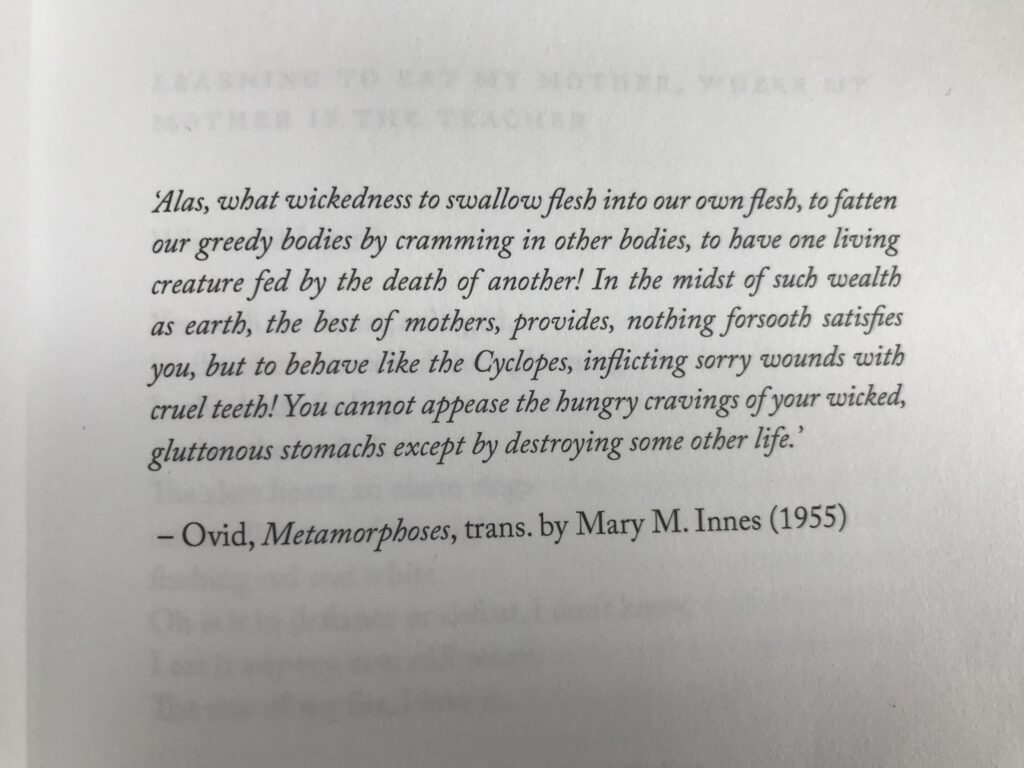
There is certainly an awareness of how this situation services capitalism too. We’ve all been sold a very specific version of adulthood that certainly doesn’t suit everyone.
We are constantly duped by this system, sold so many of our desires. There are so few spaces to reflect on the repercussions of this and I think poetry is a space for that, for me certainly and I am continually heartened by poets who challenge the status quo, whether it be Sylvia Plath and Sharon Olds, Colette Bryce and the late and beloved Eavan Boland, Natalie Diaz and Victoria Chang and so many more.
Growing up as an Irish Catholic I am intimately acquainted with the demands and constraints the institutional branch of this belief system placed, and still places, on women’s bodies and how my child-self internalised this. The collection is, in many respects, my response.
There are associations between the idea of sinning, religious devotion and absolution in your poems, the consumption, the sins of the body, etc. What do you want readers to understand from your engagement with these themes?
The poems are an exploration of sorts of what it means to consume, to be a consumer. It wasn’t a conscious decision when I began writing the poems for the book, but over time it became clear to me that they were engaging with ideas around feast and famine, denial and excess, and perhaps an attempt to find balance or stability in spite of these tendencies.
And these are individual appetites for sure, and not just in relation to food but also sex, adrenaline, the desire to connect with others, or God, regardless of cost. I was very struck by experiences I had in childhood, and I visited these memories and happenings when thinking about my father and then the collection grew from that, so it is a coming-of-age book in many respects.
The form it took was always fluid and I found collating the collection a huge challenge because the poems obviously should and must speak for themselves, but equally I would like there to be a number of possible narratives that the reader can infer depending on what order or what way they read the collection. There is an arc, in that it reflects to some degree how long it might take to learn how to be a person, especially when the society you are part of seeks to modify and subvert your desires until they become disordered.
I first came across the phrase ‘Eat or We Both Starve,’ when I was studying for my PhD in the American South and read an article about a restaurant, Taylor Grocery Catfish Restaurant, in small town Mississippi famous for a sign outside that read, ‘Eat or We Both Starve.’ Since its appearance on the porch the sign had apparently boosted their customer numbers, in addition to their excellent catfish of course. I wrote down the phrase. It’s on the margins of my research somewhere and it is something I carried around in my brain for a long time. I was drawn to the idea of survival it suggested, and how often it is dependent on our dependence on each other!
When I was writing the poems that eventually became Eat or We Both Starve, the phrase haunted me as it encompasses so many elements of the collection, the idea that consumption, in its many forms, is a chain, and we are links on it. That our behaviour has repercussions that reverberate through that chain in ways that we might not be able to predict.
The phrase symbolises the interdependence between us as humans and the animals we choose to consume, but also how we might consume, or even subsume, each other too, emotionally, psychologically or indeed by taking another’s place.
And that is a key concern of the book – how we replace each other – a child takes the place of a parent, a new lover the place of an ex – and how that can be comforting in that there is continuity but in poems like ‘Supper’ and the long sequence ‘Second Family’ a huge anxiety around this too, because it basically confirms one’s mortality and one’s very slender and often insecure or unstable place in the grand scheme of things. It references youth too, and how we as a society, and indeed as individuals, burn through that – how the culture feeds on it. The themes of the book, sex, consumption, food, grief, co-dependence, insecure attachments, all spoke to this phrase.
I guess I have always been hungry too, for food, sure but also for experience, love, connection, and how I felt that this wasn’t appropriate somehow for a young woman. In fact, it was a cause of huge anxiety. I felt like I was too big, too much. So many of the poems grapple with this quandary, how to shrink yourself into fitting in with a respectable and palatable (!) image of what a woman should be, I am thinking of ‘Big Girl’ and ‘A Young Girl Considers Her Reflection’ among others.
Yours is a serious work of poetry, it harks back to so much that I recognise from my own youth. I wonder how you feel about this association that sprang up for me. I can hear certain echoes of poets who came before us, Sylvia Plath being one, but I can also hear the rumblings of the discontent of many girls of our generation. Would it surprise you to hear that Courtney Love and that grunge rock project – the remaking and reclaiming, the building and breaking, the invasion of being looked at and touched and consumed – was writ large for me among your poems? Take the songs Doll Parts /Awful for example, there is a transference from the viewer/voyeur to the viewed. Through the alchemy of poetry and catechistic attention, I wonder if you see your work as a point on that continuum of strong women speaking truth to power individual and ordained? (as an aside, I absolutely love the use of “recapitate” in Doll Game, it might be my favourite poem in the collection)
I am not surprised that grunge is writ large in the collection, but I wasn’t aware of the true extent of its impact on my work until now. I am delighted to discover it! Thank you for sharing this observation.
Grunge is a huge personal influence as it came to Ireland at a very formative time in my childhood and early adolescence. Singers like Courtney Love, Shirley Manson and Justine Frischmann were like catnap to a convent schoolgirl growing up in County Cork! Their lyrics focused on topics that were traditionally taboo at the time like alienation, depression, suicide and heaven forbid, sexuality! For me, and for so many of my generation, grunge normalised what was once deemed countercultural.
These artists fought to break out of the patriarchal limitation on women’s behaviour, as well as their access to rock music and indeed to their own bodies. I think grunge sought to disturb culturally enforced paradigms by subverting traditional gender roles in various ways and that was, and still is, exciting and inspiring, and to speak in the parlance of the time, extremely cool. And I was all about trying, and failing, to be cool.
But that has an impact too, and not always positive, that practiced ennui, I was never very good at it. So, in antithesis, grunge was, at its most commercial, also another idealised version of the female that had to emulated – this time as a damaged but beautiful doll who looks great in torn lace and doesn’t care about anything.
I was so young; I didn’t understand the cynical element of this nor how cultural conditions like this shape gender identity and performance, and I cared so much! Writing the poems allowed me to see the stitching in my own gender construction. I am very conscious as a writer of what constitutes the ‘self’, and by extension the artist, in any culture is historically constructed and I think that is echoed in poems like ‘Doll Game,’ ‘Big Girl’ and others. And maybe too, I am now finally taking up the microphone to speak truth to power, in homage to all the rebel girls.
The poem Doll Game takes the symbolic to a whole other level, the broken necks, the reanimation, the baptism and the violence and remedy that can be committed by little girls. There’s a sort of claim being put on a masculinised type of violence here, the don’t-worry-we-can-hurt-ourselves-just-as-much, and a large part of your collection is focused on the twin themes of sinning and absolution and the concept of penance as being corporeal. Later you talk about Mary Tyler Moore getting “absolution from men everywhere”. Were you conscious of the subtext throughout the collection about the sensual converging with the sexual?
I am often confused. The poems in Eat or We Both Starve grapple with a multitude of confusions, trying to hang on to sense, looking for patterns of meaning, exerting some kind of control. The growing body is as good a place as any to start practising the art of control. There is loss too, in the growing up, the grief of letting the child-body go. The simple efficiency, the lightness of it, to be replaced by what is often perceived to be the weighty responsibilities of having a woman’s body, a body that never allows you to forget its complex and ingenious mechanics. This is at the centre of so many of the poems in the collection, a wilful immaturity, a refusal to grow up in a body that shows all the signs of maturity. Somehow, the poems, no matter what their subject, return to these paradoxes of ‘growth’ and ‘maturity’.
There is definitely a pervasive sense of the speakers in the poems, and indeed the poems themselves, being fixated on the oral stage and exploring what that might mean. It might manifest in the form of an overdependence of others for example, or in seeking out oral stimulation through drinking, eating, biting nails, and kissing.
It often points to a deep-felt insecurity and shame and, I think, indicates a somewhat reactive nervous system. There is definitely a focus on the oral because it is of course the way we begin to truly experience our bodies and our world as babies and young children. It took me a long time to move on from that stage if these poems are anything to go by. I had a huge appetite for life and experience as a child, teenager and young adult.
I wanted to eat the world, honestly. And that’s an overwhelming and giddy feeling that took so long to try and harness. I would, and there’s no other word for it, ‘get carried away’ so the poems try and engage with this, but also contain this feeling within a framework, a form.
It isn’t always successful and sometimes the words misbehave and run away from the line, or make awkward spaces, and I have made many of those in my life. So yes, these poems explore what it means to be hungry for love, for food, for history, for understanding more than anything else, and how this hunger when misdirected or indeed repressed can turn inwards and gnaw away at the self. This causes untold damage not only to the individual, but to those around her, and that this can be satisfying, as perverse as that sounds. You can get used to the adrenaline rush from intense self-hatred. It’s a drug.
There is a shift in this collection to the mother, but your pamphlet was very much about the father character. What did you learn in the six years between those publications that caused you to shift your focus from bearing witness in White Whale to utilising that power of witnessing for the deep engagement with the female in all its conceptual and literal glory. (When I say mother, I include your saints and sufferers, your sinners, the broad subjugation of women, the question of women and their bodies.)
My father died in 2010, my life forever divided into before and after. Dealing with his loss wrecked parts of myself I had constructed haphazardly, like the mask I had pressed to my face that I thought made me invincible, untouchable and mysterious. God help me, it slipped from my grasp, shattering at my feet like porcelain when he died, its pieces scattered all over. I felt raw and red. Less loved.
After White Whale, which felt both revelatory and preludial, I started writing from the root of these anxieties. Piecing together the shards of the broken façade conversely exposed the veracity of experience beneath.
I fused these jagged pieces back together with words in my approximation of the Japanese art of Kintsugi or ‘golden joinery.’ Language allows for this. Poetry allows for this, and the poems took shape, text written to repair the fissures, to make something new.
A year or two after Dad’s death I moved to Kerry, White Whale, was published by Southword Editions. From the safety of Kerry, and it felt that way, safe, I began to explore the reasons why I couldn’t deal with this huge loss in my life, why I wasn’t operating on any real level. This journey led me to explore the causes for this and as I examined myself, I was struck by the similarity of feelings I felt, though not as intense of course, when I found out at the age of six or so that meat was from animals. A huge, earth-shattering loss. It really took me that long to make the connection between animals and meat, and the two catalysts for this were my grandmother pointing to the lambs in the field outside that spring saying, ‘Soon, they’ll be on our table.’ I couldn’t believe it.
I was further devastated by the horror of turkeys hanging upside-down in the English Market in Cork that Christmas. I think it was the official beginning of my end of innocence. I was very unnerved by these revelations. I became more anxious and worried about what else might be hidden from me, and this I suppose led to a terror of puberty, which I found torturous, and a fear of growing up. What other shocks could the grown-up world have in store for me?
In my poems then, I started to think about how eating and consumption has implications on the maturing body, a fear of becoming a woman, of sexuality, of the horrors of the past and history, of the future. So, the initial crisis of my father’s death made me analyse how I had constructed a female self, terrified at the prospect of loss, of benefiting from another’s death, in this case animals, and a denial of the very essence of life – death.
I didn’t know when I was six that I was experiencing was an existential crisis and a crisis of sexuality too – grappling with the oncoming freight train of sexual maturation hurtling down the line.
I suppose you could say I was extremely sensitive, which I have now learned to embrace rather that reject. I had to rebuild myself from the ground up, and many of the poems come from that struggle. My inner reserves were insufficient and that my chosen path at that point, academia, had let me down badly. It didn’t furnish me with the resources needed to survive my father’s death and my subsequent breakdown, and neither did the church, though I found its funeral rituals very comforting and important, I didn’t connect with its message spiritually or practically.
I had very little emotional resilience. I was also struck at the time by a phrase my now husband said to me when I was particularly broken, and it was revolutionary and challenging and brave, ‘You are not your emotions.’ That was the moment I fell in love with him and his view of the world, his way of being in it that was so different to mine, which was then a chaos of emotion and reactive behaviours. He helped me learn to respond, and to try to healthily acknowledge my emotions but also to detach from them.
So that gave me the space to see my journey, which is far from unique, and gave me permission in a sense to deconstruct and examine the often-extreme coping mechanisms we use to survive.
My poems are written in the only way I could write them – to be true. Among other things, they are a belated farewell to a difficult, extended girlhood and an embrace of a more complex – but I hope, healthier – womanhood, with all that entails. This journey didn’t start until my world broke apart and that mask fragmented, but the funny thing is that my mask never really worked anyway. Everyone saw me, except myself.







